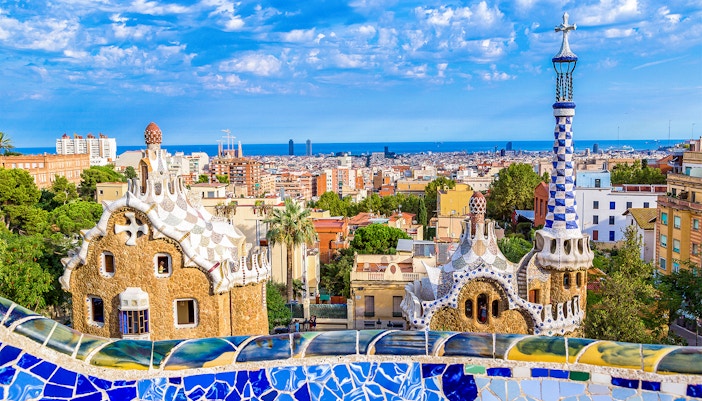Gaudi designed an eye-catching park entrance using theatrical style constructions with the use of colour and exoticism on the buildings that aimed to distinguish between two areas: Heaven and Earth, and Park Guell is the Paradise.
- Park Guell
- Park Guell Monumental Zone
- Dragon
- Gaudi House Museum
- History
- Architecture
- Inside
- Park Guell Sunset
- Antoni Gaudi
- Sagrada Familia to Park Guell
- Accessibility
- Nature and Biodiversity
- Plan Your Visit
- Skip the Line Tours
- Guided Tours
- Timings
- Directions
- Rules
- Entrances
- Restaurants
- Facts
- Tips
- Map
- Free Entry For Locals
- UNESCO World Heritage Site
- Parking
- Audio Guide
- Sagrada Familia
- Barcelona Flamenco Show Tickets
- Camp Nou Tours
- Casa Batllo
- Casa Mila Tickets
- The World of Banksy Barcelona
- Portaventura World
- Gaudi Tours Barcelona
- Hola Barcelona Travel Card
- Wax Museum Barcelona
- Palau de la Música Catalana Tickets
- Erotic Museum of Barcelona
- Montserrat Monastery
- Barcelona Zoo
- KBr Photography Center Mapfre Foundation
- Big Fun Museum
- Barcelona Aquarium
Park Guell Architecture & Design | Gaudi's Modernisme Marvel
Architecture & design of Park Guell | quick overview

- Official Name: Parc Guell (Catalan)
- Status/Function/Attraction Type: Municipal Garden
- Location: Carmel Hill, Gracia, Barcelona
- Founded: 1914
- Area: It occupies 17 hectares of space, including the forest, monumental and panoramic areas.
- Architectural Style: Modernisme
- Main Architects: Antoni Gaudi
Park Guell photos








Structure of Park Guell

Park Guell is one of the largest parks in Barcelona covering 19 hectares of land. You will see Gaudi’s most original and enigmatic creations. Some of the creations you can see are
- The colourful mosaic dragon at the main entrance
- The undulating bench of the central square
- The entrance pavilions
- Museu del Garda (Guard Museum)
- Sala Hipostila (the Hypostyle Room)
- Placa de la Natura (Nature Square or terrace)
- Jardins d’Austria (Gardens of Austria)
Architecture of Park Guell
The Entrance
The exterior of Park Guell

All the sections in the Park Guell are built with unique designs and structures. Once you are done taking a tour of the park, the park offers relaxation areas and recreational facilities such as games and outdoor activities.
A marvellous yet sprawling wonderland, the Park Guell follows an architectural style inspired by nature and colourful mosaics and is Antoni Gaudi’s greatest creation. Filled with whimsical sculptures and motifs of Catalan modernism, the park continues to be famous for its architecture. Today, Park Guell has more than 12 million visitors every year visiting from across the globe and most of them leave mesmerised with the architectural wonder.
Book your Park Guell tickets & tours
Frequently asked questions about Park Guell architecture
Park Guell is designed in Modernisme style, which is characterised by curved lines and vivid colours.
Park Guell was designed by Antoni Gaudi between 1900 and 1914.
The Park Guell’s architecture is famous for having designs that are inspired by the nature, curved lines, and motifs of Catalan nationalism, making the park an architectural marvel.
The Park Guell was inspired by the English garden city movement.
The Park Guell was built between 1900 to 1914, which later opened as a public park in 1984.
Park Guell is 109 years old.
Inside Park Guell you will spot architectural elements and flora that blend perfectly together. The significant highlights of the park include the Hypostyle Room, The Greek Square, the Dragon Stairway, The Lodger’s Pavilion, The Viaducts, The Laundry Portico, and Roads and Pathways.
Park Guell covers an area of 19 hectares that is inclusive of monumental, forest, and panoramic views.









